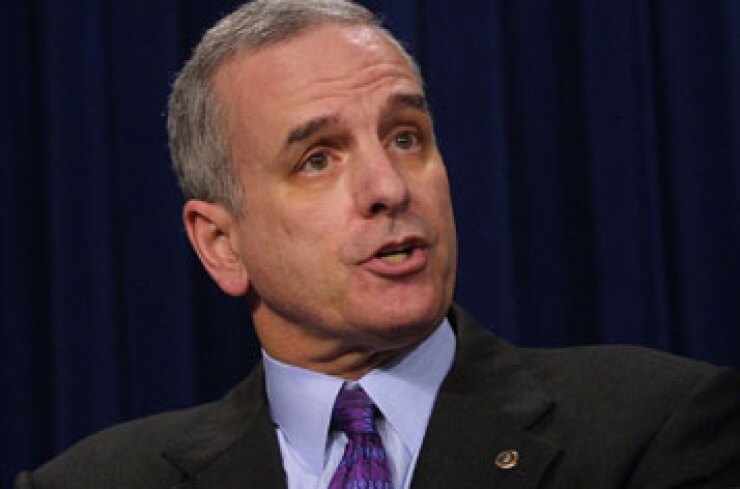
CHICAGO - Minnesota raised its projected budget surplus by $400 million to $1.2 billion on Friday setting the stage for a debate over spending, reserves, and tax cuts.
The state's improved revenue showing also could help Gov. Mark Dayton make the case for a sizeable bonding package to fund infrastructure projects. Dayton wants a $1 billion bill but lawmakers in recent years have approved less he's than requested.
The annual February forecast from the Minnesota Management and Budget office raised the estimated surplus by $408 million. General funds for the biennium ending June 30, 2015 are expected to total $39.6 billion, $366 million higher than the state's last formal forecast in November. Spending is estimated as $39 billion, down by $48 million. The projections are offset by the need to put $6 million in the reserve for a new Minnesota Vikings stadium.
The revised projections also offer good longer term news with a balance of $2.6 billion expected in the next biennium before any spending growth is counted.
The state's coffers have grown more flush thanks to an improving economy and an income tax hike on the wealthiest residents approved last year. The latest figures provide a stark contrast to the state's fiscal position a few years ago when the state was grappling with a $5 billion deficit.
"Now, we have the responsibility, and the opportunity, to extend our contribution to our state's continuing improvement, by deciding how best to allocate this biennium's $1.2 billion surplus," Dayton said in a statement. He will unveil a supplemental budget plan next week.
"The individual and business tax cuts in the House tax bill are a very good start," he said.
Dayton's Democrat-Farmer -Labor Party enjoys legislative control.
The House bill Dayton referred to includes $500 million in tax cuts. Dayton late last year said if the February forecast showed strong revenues he would propose repealing three business sales taxes and provide state tax breaks similar to federal ones.
The state does not face any statutory requirements about how to use the surplus as it did with previously projected ones. The state used surpluses in 2012 and in early 2013 to catch up on several billion dollars of overdue school aid payments that had been withheld to deal with a prior deficit.
The state's general fund reserves hold $1 billion, including $350 million in a cash flow account and $661 million in the formal budget reserve, an amount equal to 2.6% of general fund revenues. Some lawmakers want to bolster reserves with the surplus.
The February forecast reports that higher income and sales taxes account for the gains in the current biennium. Income taxes account for $188 million of the February increase and sales taxes account for $167 million.
The state's economy continues to make solid gains with its gross domestic product rising 3.5% in 2012 and labor market indicators suggest a similar trend in 2013. The state ended the year with a 4.6% unemployment rate, two percent better than the nation.
The projected $2.6 billion balance in the next two-year budget does not account for inflation which is projected at 1.7% in fiscal 2016 and 1.8% in fiscal 2017 and would trim $1 billion from the balance. "Economic changes as well as the nature and timing of any budget changes may materially affect both revenue and expenditure projections for the next biennium," the report warns.
The revenue forecast is accompanied by debt projections that show the state has additional room to borrow without bumping up against its guidelines. The state aims to limit tax supported principal to 3.25% of total state personal income and total principal authorized for all state related obligations to no more than 6% of personal income.
The state has room to borrow an additional $732 million of tax-supported debt under the first before hitting 3% of state personal income and up to $4.6 billion under the second before hitting 4.25%.
Minnesota has $6.25 billion of outstanding general obligation bonds and $1.64 billion of other tax-supported obligations outstanding, with another $1.56 billion of authorized but unused GO authority.
The state typically passes a large capital package in the year after approving a two-year operating budget with smaller bills approved alongside the operating budget. Lawmakers last year approved a $156 million program as they tackled a new two year operating budget. Two years ago lawmakers approved a $566 million bonding package after Dayton asked for $750 million.
The state carries GO ratings in the high-double-A category.





